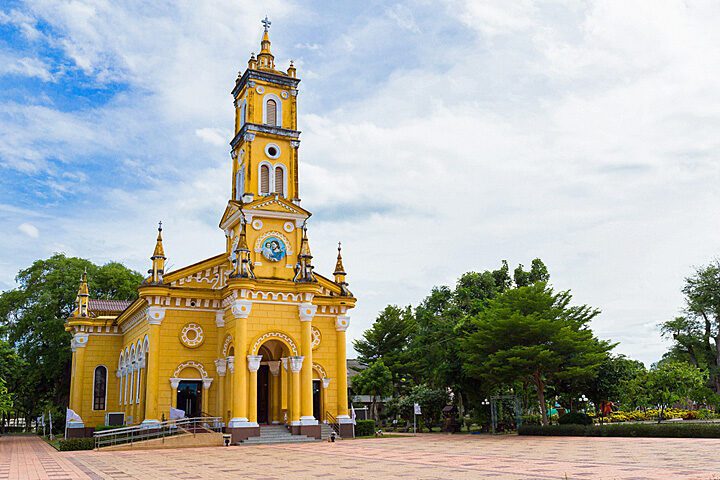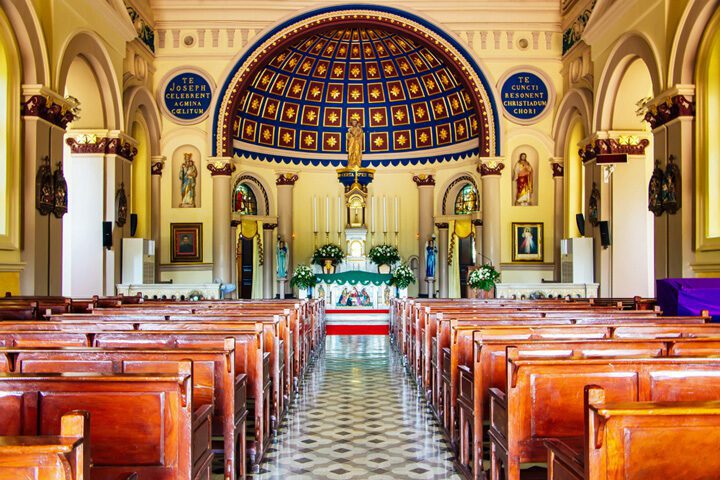The Christian Past of Ayutthaya

Saint Joseph Church
'I continue to admire this very large city, on an island surrounded by a river three times the size of the Seine, full of French, English, Dutch, Chinese, Japanese and Siamese vessels, an innumerable number of flat-bottomed boats and gilded galleys with as many as 60 oarsmen .'
'Even more admirable is that on both sides of this island neighborhoods and villages are inhabited by different nationalities. I have never seen anything so beautiful and all that, with the exception of the (gilded) pagodas, of a natural simplicity.'
The 41-year-old Frenchman Abbe de Choisy wrote this down in 1685 Ayutthaya, then one of the largest cities in Asia. Thailand has played host to many strange and unusual characters over the centuries, but de Choisy, a cleric and member of the French diplomatic mission in Ayutthaya, was among the strangers. His mother had raised him as a girl and he favored a transvestite lifestyle, seducing mainly young girls. After recovering from a serious illness, he renounced his former life of debauchery in favor of religious and diplomatic pursuits.
The first European traders to arrive in Ayutthaya were the Portuguese, in 1511, who were quite impressed by the city and called it “the Venice of the East”. A title, by the way, which was adopted by Bangkok a few centuries later. The Portuguese language became the lingua franca of trade for most of Asia for a long time in the 16th century. To Asians, the Portuguese were known as feringhi (from which it is not difficult to see that the modern Thai word farang derives from it) and were highly regarded as trading people. Trade in arms and ammunition, which the Thai successfully used against the Burmese, was an important activity of theirs.
In 1540, the Thais granted the Portuguese permission to build a settlement outside the city walls in the south, of which only the remains can now be viewed. The restored church of Saint Peter', which was originally founded by the Dominicans, is the most important of the remains of that settlement. At its peak, there were over 300 Portuguese citizens living in Ayutthaya, many from the Portuguese colony of Goa in India. The foundations of the church were discovered in 1985, along with the remains of about 200 people in what was believed to be the local cemetery. The church is open to the public and inside you can see the skeletons up close.

Saint Joseph Church – AYUPhotoG / Shutterstock.com
The Portuguese wish was to break the Arab monopoly in the spice trade. They showed themselves to be true missionaries and Duarte de Coelho, the third Portuguese envoy to Ayutthaya, hung a wooden crucifix in the streets of the city so that the Thai citizen could see how Jesus Christ had died for all people. Of course, this has not had much influence on the thinking of the average Thai.
It did not really bother the Siamese kings that the Europeans made efforts to convert their subjects to Christianity. One Father Pedro from Lisbon wrote in 1589: “I have preached several times among these pagans, but - stubborn as they are - they say that they will continue to believe in what their fathers have always believed. So if their fathers go to the devil, they too go to the devil.” 'The emphasis on monogamy and the prohibition of divorce are the most important factors in the failure of Christian evangelization.
While some of the laws of ancient Ayutthaya were considered unusual by European standards (death by tiger, for example), the law on divorce was very enlightened: “If a husband and wife have a physical or mental aversion to each other and express a desire to to divorce, that wish may be granted, because if two people no longer see the point in a marriage, they should not be forced to continue living together.”
The Dutch Church of St. Joseph's (the Hollandse Sint Jozefkerk) see photos, some call it a cathedral, with its faded yellow colors and the bell tower, it looks a bit strange in the area. The Dutch East India Company (VOC) established a trading post in Ayutthaya in 1608, which was destroyed by Burmese troops 159 years later. After helping the Thais against the rebellious state of Pattani around 1640, the VOC was given a piece of land south of Ayutthaya, where, among other things, this church was built. Some of the original foundations can still be seen near the river.
Article by Duncan Stearn in Pattaya One translated by Gringo.
– Reposted message –


A particularly nice work is also Phaulkon (etc) by George A. Sioris , a former Greek ambassador to Thailand, published by the Siam Society.
This Vichayen had made it far at the court of King Narai, but the Dutch eventually gamble on Petracha and that also meant the end of the man's career and it also led to Mr. Gerakis having to breathe his last and that in a less pleasant way.
Many people think that Gerakis, the falcon, was the most important foreigner ever, but then they are wrong.
That was of course the very sympathetic and brilliant Belgian legal scholar Gustave Rolin Jaquemyns, who was coined by King Rama V with the Siamese noble title Chao Phya Abhai Raja Siammanukulky.
Search for Professor Herbots' valedictory speech at the University of Leuven.
I thought he titled it 'a comparatist in the land of the white elephant'.
Without exaggerating too much, it was thanks to this exceptionally intelligent and honest man that Siam was never colonized. He trapped the French after the Paknam incident of 1893. Again: brilliant Belgian and citizen of the world
Elsewhere I have written about the particularly good relationship between Prince Damrong and our own hydro engineer Homan van der Heyden, which culminated in his insistence on sitting down with Homan at the 1932 dinner held by the mayor of Amsterdam in honor of the Siamese princely guest. at the Tropical Institute.
But what, dear friends, do you say of the same Prince Damrong (Rajanubhat) who personally brings southern neighbor Gustave Rolin Jaquemyns to the boat (in 1903 or so?) and before Gustave goes up the gangplank takes a ring from his princely finger and gives to Gustave?
By the way, I wonder if the Dane Plessis de Richelieu, who was still the admiral of the Siamese Navy at the time, was also present. I don't think those two got along....
When Prince Damrong, who discovered Gustave more than ten years earlier during a garden party of the British ambassador in Cairo, came back to Europe, Gustave had unfortunately already passed away.
To return for a moment to the end of King Narai's reign, in which the Dutch played a rather special role in the background: after Petracha had taken over the business and had sent his fellow council members to a new life, the Dutch suddenly traded only hides with Japan.
They were handsome men, those gentlemen of the VOC! Top businessmen!
Homan van der Heyden is still honored by the Thai to this day.
in June I was a guest at RID (royal irrigation department) in Bangkok, where the 111th anniversary was celebrated.
Here the name and person Homan van der Heyden was seen as the founder of solving their irrigation problems by starting various projects in collaboration with the Thai king.
greeting
http://thailandforvisitors.com/central/ayuthaya/sri-ayutthaya/st-josephs-church.php
Our daughter went to the St. Joseph affiliated primary school, excellent education, now does international business at an excellent university.
Even more about Ayutthaya
http://www.chiangmai-chiangrai.com/glory-of-ayutthaya.html